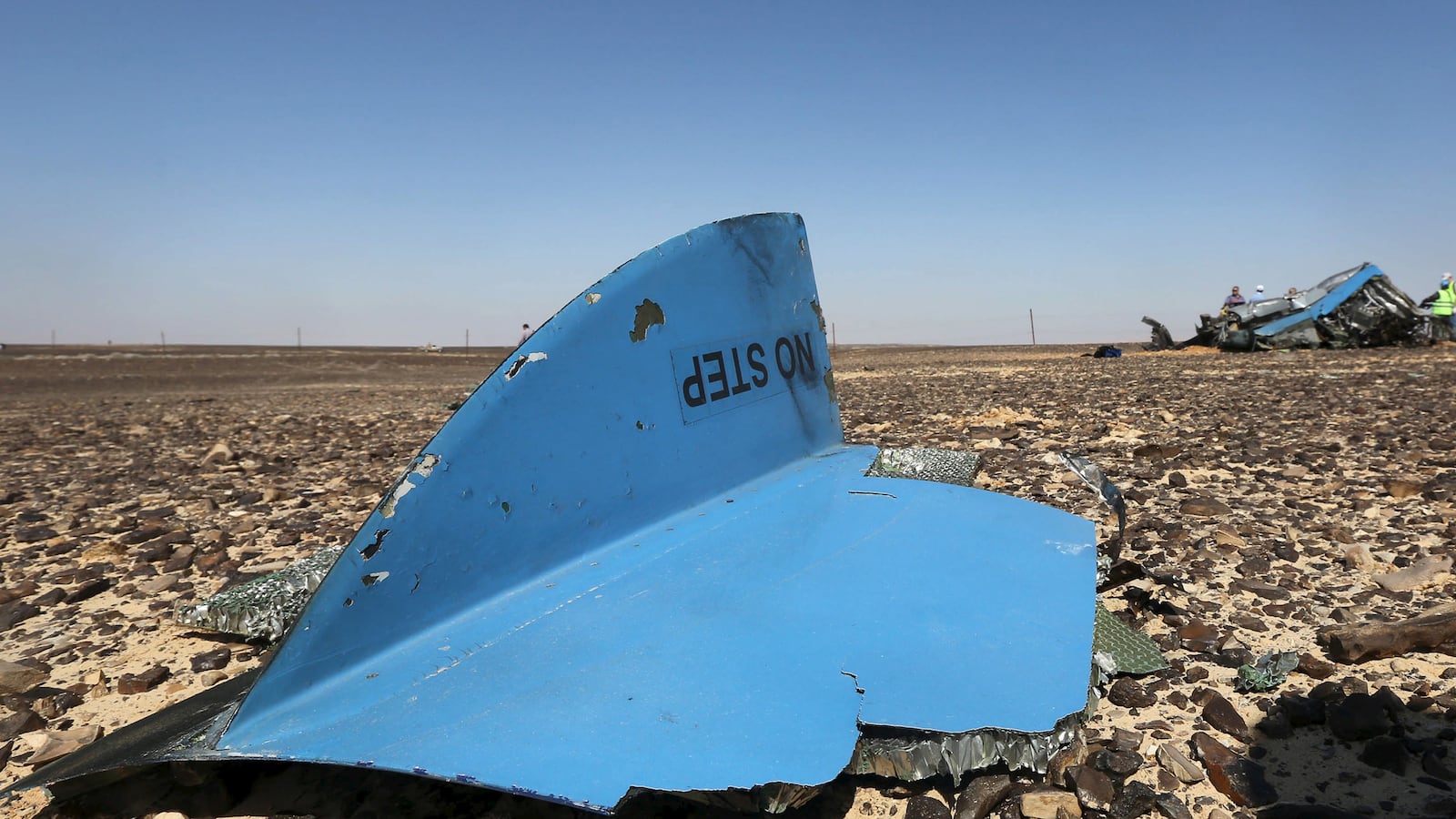In the absence of any definitive evidence that an explosive device brought down Russian Metrojet 9268 last month over Egypt’s Sinai, U.S. intelligence and security officials have been debating a number of competing theories about how the plane crashed, including that ISIS militants may have used a novel or previously unseen device that has made it harder for investigators to find forensic evidence of a bomb.
Among the theories U.S. officials are considering is that the bomb may have been placed near a fuel line on the doomed Airbus jet, and that it was just large enough to ignite a fire using the fuel in the aircraft’s tanks, two sources familiar with internal discussions told The Daily Beast.
If that was the case, it’s possible that investigators might not find telltale explosive residue that would prove a bomb had been detonated, the sources said, requesting anonymity in order to discuss sensitive information related to the unfinished investigation of the crash.
But others see evidence of a more traditional attack.
A former senior U.S. official who was shown an investigation photograph of the wreckage told The Daily Beast that a portion of the underside of the plane shows small, quarter-sized holes and looked like something had blown out of the plane from the inside.
This information led the former official to conclude that the jet was brought down by improvised explosive device, possibly packed with nails and other shrapnel to blow as big a hole in the side of the plane as possible. From there, the plane could have broken up in mid-air, which is about the only thing U.S. officials are sure happened, since the wreckage is spread over a vast area.
The former official spoke on condition of anonymity in order to discuss confidential information that was shared with him from the investigation.
The lack of any concrete evidence has frustrated U.S. officials, who are trying to piece together a narrative from a continent away. They also still cannot rule out a major structural failure. The tail of the aircraft had been damaged during a hard landing in Cairo in 2001.
The slow pace and lack of transparency in the investigation also underscored how dependent crash investigators are on evidence collected at the scene. Egyptian officials are leading the investigation, but U.S. officials expressed little confidence in how they’re running the scene.
“Information from the Egyptians on the investigation is coming out rather slowly,” a U.S. official told The Daily Beast, attributing the paucity of sharing both to the Egyptians’ lack of technical sophistication and their unwillingness to conclude that this was an attack against tourism, one of the key pillars of the national economy. The Metrojet flight originated at Egypt’s Sharm el Sheikh airport, a resort area that is frequented by foreign travelers and that authorities have long said was beyond the reach of Islamic militants in Sinai.
By now, investigators arguably should have had answers. It took forensic specialists eight days to be certain that Pan Am Flight 103 was brought down by a bomb over Lockerbie, Scotland, in 1988, after they found residues on the plane’s debris that “positively identified and are consistent with the use of a high-performance plastic explosive,” investigators said at the time.
But 11 days have passed since the Metrojet crash with no hint that any forensic evidence has been found.
On Tuesday, the Egyptian foreign minister told CNN that the government had approved applications by the U.S. National Transportation Safety Board, which investigates all aviation accidents involving American planes, to come to Egypt and examine the wreckage.
But an NTSB spokesman told The Daily Beast on Wednesday that, according to the board’s head of aviation safety, the Egyptians have still not reached out and said that the investigators can come.
The FBI has personnel serving in Cairo, but they are not at the crash site, nor have they been invited.
“The FBI has offered forensic assistance and other services to our partners in Egypt and Russia, and stands ready to assist,” Joshua Campbell, a bureau spokesperson, said in a statement.
A senior Defense Department official told The Daily Beast that without access to the crash site, investigators have been forced to rely largely on satellite intelligence and speculation. The official said suspicion that the plane was probably brought down by a bomb is based largely on thermal imagery detected from a satellite that suggests a massive explosion, likely the result of jet fuel igniting.
That might argue in favor of the fuel-line theory. But if that was the case, it’s also not clear why the wings of the doomed jet appear to be largely intact, based on crash scene photos. The wings are badly charred and inverted, which suggests that the plane landed on its back. But they were not blown away.
A senior U.S. intelligence official said that if a bomb did bring down the plane, it was almost certainly not placed there by a passenger. Instead, attention has focused on ground crew at the airport with access to the airplane when it was preparing for its flight to St. Petersburg.
The Associated Press reported this week that “security checks were often lax at a gate into the facility used to bring in food and fuel,” citing security officials at the airport.
“Sharm el Sheikh is a tourist airport geared towards tourism. Many times secondary airports do not have the level of security found at the larger international airports,” security consultant John Halinski, the former deputy administrator of the Transportation Security Administration, told The Daily Beast. Halinski also ran TSA’s overseas airport inspections earlier in his career.
“I have always been concerned with the insider threat in this region, especially with a group like ISIS that radicalizes over the Internet,” Halinski added. “Generally, screening and vetting of employees in this region occur only once every few years.”
—with additional reporting by Kim Dozier, Kate Brannen, and Nancy A. Youssef





